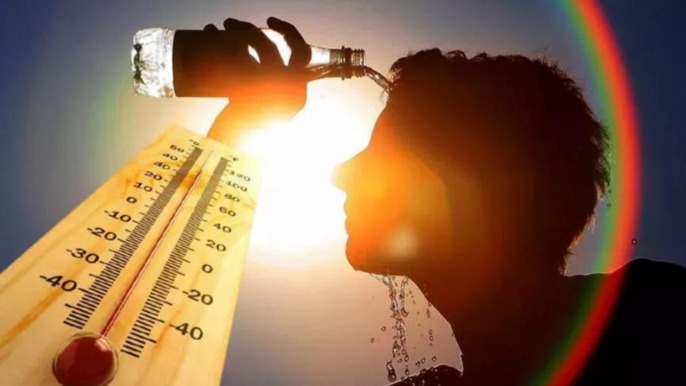Heat Waves and Public Health: An Emerging Crisis
Heat waves are prolonged periods of excessively high temperatures, often accompanied by high humidity, that can have significant impacts on human health, ecosystems and infrastructure.
According to the WMO, a heat wave is a period of “marked unusual hot weather (Max, Min and daily average) over a region persisting at least two consecutive days during the hot period of the year based on local climatological conditions, with thermal conditions recorded above given thresholds.”
Heat waves are now recognized as a serious and growing public health crisis—particularly in densely populated urban areas with inadequate infrastructure. In recent years, the frequency and intensity of heat waves have increased dramatically due to global climate change. Once considered occasional weather anomalies, heat waves are now emerging as persistent public health threats in many regions. As a result, vulnerable populations-including the elderly, children, outdoor workers, and those with pre-existing health conditions- are facing heightened risks. As temperatures continue to rise, the human body’s ability to cope with extreme heat becomes increasingly strained, especially among vulnerable populations.
Heat waves pose both direct and indirect threats to health. Direct effects include dehydration, heat exhaustion, heat stroke, and even death, particularly among the elderly, young children, people with pre-existing health conditions and outdoor workers. Indirect effects can be equally severe, such as exacerbation of cardiovascular and respiratory diseases, Disruption of essential
services, power outages, and increased air pollution levels. In urban centers, the “urban heat island” effect—where concrete surfaces trap heat—exacerbates the risks, making cities significantly hotter than surrounding rural areas.
According to the World Health Organization, over 166,000 people died due to heat waves between 1998 and 2017. The 2003 European heatwave alone caused more than 70,000 excess deaths. In more recent years, heat events in South Asia, North America, and parts of Africa have pushed health systems to their limits.
Bangladesh is increasingly vulnerable to the health impacts of heat waves due to its geographic location, high population density, and limited adaptive infrastructure. In recent years, regions such as Rajshahi, Khulna, and Dhaka have experienced prolonged periods of extreme heat, with temperatures frequently exceeding 40°C during the pre-monsoon months. These conditions have led to rising cases of heat-related illnesses, particularly among outdoor laborers, slum dwellers, and low-income communities without access to cooling facilities.
According to Unicef, what should we do in a Heat wave-
Be prepared
- Know how hot and humid it is going to get today, this week and this month to help plan outside activities.
- Keep an emergency kit at home that contains oral rehydration salt (ORS) packets, a thermometer, water bottles, towels or cloths to wet for cooling, a handheld fan or mister with batteries, and a checklist to identify and treat symptoms of heat stress.
- Know how to get help. Note down the contact information for the nearest health care provider or ambulance/transport services.
Keep your home cool
- When possible, close the curtains during the hottest parts of the day and open windows at night time to cool down the house.
- Use fans and coolers if available.
Stay out of the heat
- Do not go outside during the hottest times of the day if you can avoid it. Try to arrange your activities earlier or later in the day when it is cooler.
- When outside, wear sunscreen and try to stay in the shade or use hats and umbrellas for protection.
Stay cool and hydrated
- Drink water at regular intervals before you are thirsty.
- Overdressing in the heat can make you dehydrated and hotter faster, so wear light and loose clothes. Cotton is ideal during hot days to help reduce heat rashes and absorb sweating. Similarly, cotton bed sheets are recommended over non-breathable materials.
- Carry a water bottle and a small towel, so you can hydrate and cool down by placing a wet towel on your neck.
- Check to see if your community has a heat relief or cooling center near you. You could also use the waiting areas of health facilities as a temporary cooling shelter.
Addressing this emerging crisis requires a multisectoral, proactive approach. Public health agencies must integrate heat preparedness into their emergency response systems. Early warning systems, mobile health alerts, and community awareness campaigns can play critical roles in saving lives. Urban planning should prioritize green spaces, reflective building materials, and shaded public areas to reduce urban temperatures. Healthcare providers must be trained to recognize and treat heat-related illnesses quickly and effectively.
In conclusion, heat waves are no longer rare weather anomalies—they are deadly, predictable, and escalating in frequency due to climate change. The health impacts are immediate, preventable, and deeply inequitable. Treating extreme heat as a public health emergency is no longer optional. It is a necessary step toward protecting populations, especially the most vulnerable, from one of the most pressing consequences of our changing climate.

